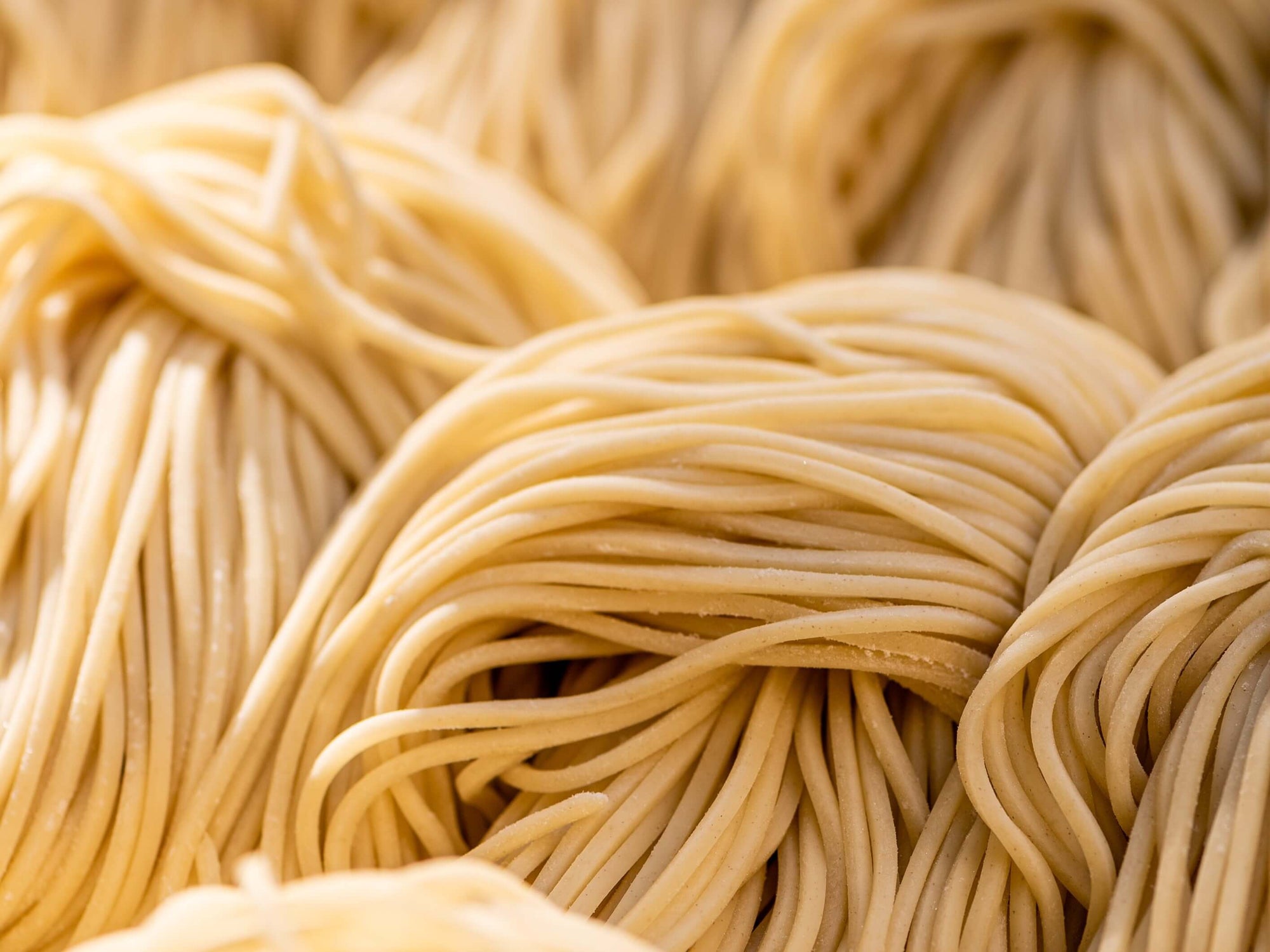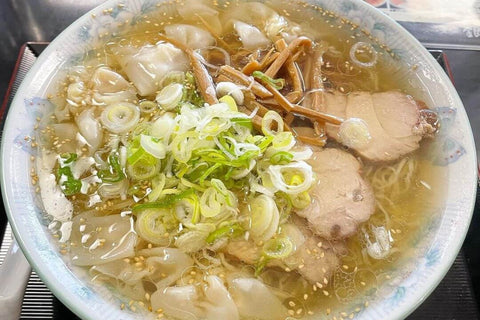

· By Anonymous Noodle Guide
The Nakama Noodles' Guide to Japanese Ramen
While sushi is Japan’s most famous food, ramen is actually a close second that might overtake sushi in the future. The variety of ramen styles and flavors, the spread of cup ramen, and its spread from Japan to overseas are a few reasons why it’s gaining popularity. Get in on the international ramen boom with our guide to Japanese ramen.
Originally a Chinese dish coming to Japan from China, many Chinese merchants and immigrants opened shops and stalls selling the dish. However, much like curry and other international dishes, the dish was changed to fit the unique tastes of Japanese people, making Japanese ramen different to Chinese ramen.
With Japanese ramen taking on its own flavor, it also spawned different types, styles, flavors and more. Let’s start with the types of ramen!
Types of Japanese Ramen

To understand the ramen world, it’s important to understand the different types of ramen. This is probably the easiest step to diving into the ramen world since there are only four types. You have shio (salt), shoyu (soy sauce), miso (fermented soy bean paste) and tonkotsu (pork bone). These are your four bases and everything else comes from them.
These styles don’t just have a different base. They also have different properties that make them unique from one another. Shoyu is a consistent and trusted broth with a little bit of saltiness. Meanwhile, miso has a slightly nutty flavor due to the fermented soy bean. Shio is a complex soup that demands a delicate balance of salt with other ingredients. Last, tonkotsu has a meaty flavor that mixes well with the other bases.
But there’s more to ramen than these four bases. That’s why we have a trusty guide to the types of ramen available in Japan.
Regional Japanese Ramen Styles

Yes, we love the main four types of ramen and all the delicious flavor they have to offer. However, where ramen is really allowed to shine is in the regional ramen styles and varieties. Unique styles spring up in local areas, with some of the more popular ones spreading to other regions or even overseas.
When thinking about why these different styles pop up, a few come to mind. First is that ramen cultures differ from area to area. For example, some local styles use thin noodles to help make the ramen faster for busy workers. Another factor is what’s available locally. Hokkaido, for example, is famous for dairy, so one of the local ramen styles incorporates butter made from local dairy.
Looking for a more in-depth guide to some of the most popular local ramen around Japan? Check out our blog about regional ramen styles.
Hokkaido Ramen

Hokkaido ramen is a well-loved category of ramen. However, saying that you like Hokkaido ramen is like saying that you like anime. There are subgenres to Hokkaido noodles, including Sapporo ramen, Hakodate ramen, Asahikawa ramen and more. In fact, check out all of the different Hokkaido styles and you’ll probably find all four of the main ramen types.
However, Sapporo’s miso ramen stands out among the rest and is actually so popular that it is considered one of Japan’s top three most popular ramen types. Sapporo miso is truly a local product with many shops incorporating toppings grown or produced in Hokkaido. Think toppings like corn or butter from Hokkaido’s famous dairy industry. In fact, the combination of butter and miso ramen has led to the popularity of Hokkaido butter ramen across Japan.
While Sapporo miso is a star, to sleep on the other Hokkaido styles would be a mistake. With all of the local types of ramen in Hokkaido alone, we’d be here all day talking about them. So if you want to learn more, check out our thorough guide to Hokkaido ramen!
Hakata Ramen

Hakata ramen, or Hakata style, has really taken Japan by storm, becoming another one of the top three, thanks to how flavorful it is known to be. This tonkotsu ramen gets its name from Hakata ward in Fukuoka City, Fukuoka Prefecture and is famous for its rich, creamy broth.
Hakata style is made by boiling pork bones on high heat for a long time until the bone breaks down and creates a milky, delicious broth. Meanwhile, the noodles for this style are thin and cook very quickly, but there is a drawback to the thin noodles.
They get soggy faster than thicker noodles, but that’s where an interesting piece of ramen culture comes from. Instead of providing a large portion option for noodles, shops offer hungry customers kaedama (replacement noodles). This allows you to eat the ramen in the soup, get more noodles to put into your soup, and enjoy tasty noodles without them getting soggy.
You may know Hakata style ramen from franchises like Ippudo, Ichiran and Hakata Ikkousha, but check out our deep dive into Hakata ramen to learn more and get more recommendations.
Kitakata Ramen

The last entry into the big three ramen styles is Kitakata ramen from Kitakata City in Fukushima Prefecture. This style is a shoyu base that is beloved among locals to the point of being considered a totally normal breakfast food. This is thanks to its unique broth, noodles and ramen culture, which is why there are over 120 shops in this small city.
It’s truly a wonder that manages to balance a deep, delicious flavor without being too heavy. You see, Kitakata has a unique position close to Mount Iide that blesses the town with super fresh water. This water goes into the noodles, the shoyu used in the soup, and the soup itself. This helps to create a flavorful yet clean soup that people around the country love.
And about the breakfast ramen, this unique bit of ramen culture developed over the years. Factory workers coming off of night shifts, farmers looking for a quick treat before work, and ramen lovers in general are who this culture was made for. This means that if you visit the city, you can go to plenty of shops that open at 7AM, meaning that they do prep much earlier.
Want to explore the amazing world of Kitakata style a bit more? Check out our blog all about Kitakata ramen and what makes it so special.
Yokohama Ramen

While not one of the top three ramen, we think this popular ramen style deserves a shoutout for how delicious it is. Yokohama ramen, officially called Yokohama Iekei ramen, is a Hakata tonkotsu and Tokyo chicken shoyu hybrid ramen dish. It was created by a truck driver, Yoshimura Minoru, who trained to become a ramen chef after thinking of the idea to combine the two during his time on the road.
Iekei ramen is known for its very rich flavor, thick noodles, simple toppings and chicken oil. The richness comes from both the soup combination and use of chicken bones and skin in the broth. The noodles and simple toppings all act as vehicles to get more of the soup into your mouth. Meanwhile, chicken oil can help to alter the flavor of the ramen, fitting it to the diners’ personal tastes.
This ramen style was created by a blue-collar man for a blue-collar audience. Because of that, the taste is sometimes thought of as simple and is sometimes misunderstood by hardcore ramen enthusiasts. However, this local ramen type is well-loved by regular ramen lovers with refined enthusiasts starting to come back around to appreciate it.
Want to learn all about what makes Iekei ramen so delicious yet misunderstood? Then check out our guide to Yokohama ramen to become an Iekei master.
Cup Noodle

You can’t talk about ramen without talking about Cup Noodle, the first cup ramen sold on the market. Created by Momofuku Ando (who also created instant ramen), Cup Noodle has integrated itself into countries all over the world as a tasty but wallet-friendly noodle experience. However, did you know that it wasn’t always like that?
Instant noodles were initially released at a high price and were a luxury item at first. And did you know that Cup Noodle was inspired by the way chic Americans ate instant noodles? Momofuku Ando saw how Americans ate instant noodles using cups and thought of the actual cup ramen product, which continued to be a chic, stylish product for some time.
Nowadays, there are so many flavors out there both in Japan and abroad. Of course, Japan creates plenty of unique flavors that you can’t find anywhere else. However, Cup Noodle has created iconic flavors for specific countries that have cemented themselves as top cup ramen flavors in those countries.
To learn more about the history of Momofuku Ando’s invention and some of the most interesting flavors available around the world, check out our guide to Cup Noodle!
Cup Noodle Museum

Besides our guide about the history of Cup Noodle, a great way to learn and experience the history of Momofuku Ando and his product is the Cup Noodle Museum. This museum has two different locations in Yokohama and Osaka, both having their own attractions and exhibits with a few in common.
This is a popular attraction for local residents, domestic tourists and international tourists, and with experiences like making your own instant Chicken Ramen and your own unique cup ramen. Add the fact that you can eat tons of noodles at the Yokohama Noodles Bazaar and the Osaka Tasting Room, and you can easily have a good time at either of the two locations.
This museum really has so much more to offer than what we listed here, so check out our guide to the Cup Noodle Museum to learn more about it. (And maybe use it to plan your museum trip).
How to Improve on Instant Ramen

Speaking of instant noodles, Japan is spoiled with tons of premium options from seasonal ramen bowls to affordable ramen packs. While all of these instant options are fine on their own, ramen pros know how to turn a simple bowl or pack into a full restaurant-level experience.
Adding vegetables is a great way to add volume and nutrition to a meal. Meanwhile, proteins, like pork belly, chicken, egg and beef, can add depth to the meal while also helping you to stay satisfied longer. The right seasonings (like chili pepper, sesame seeds and yuzu pepper) can also help to bring out the natural flavors of the dish.
You can also use some more unique or advanced techniques. Adding butter or cheese can add plenty of flavor to the broth. Meanwhile, changing up the broth with add-ins like soy milk or tomato soup can create a higher-quality experience. Also, adding rice is a great way to make the most of the leftover broth!
Need to know more about how to up your ramen experience? Check out our blog all about how to improve instant ramen!
We can’t talk enough about how much we love ramen, and we hope that our guide helps you out on your own personal noodle journey. Of course, we couldn’t go in-depth into everything, so be sure to check out our other Japanese ramen blogs for more information!
What do you love about Japanese ramen? What is your favorite style? Are there any you want to try in particular? Let us know in the comments!
